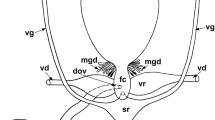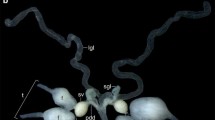Summary
During each moult the anal glands in Rhapidostreptus virgator are partly dissolved and subsequently rebuilt and enlarged by embryonic cells within the anal sac epithelium. An embryonic cell undergoes two mitoses thus producing the four cells which are present in a glandular unit. During the genesis of the glandular units each of the latter secretory cells produce a ciliary process, which is believed to serve as a mould for the canal cell, which in turn secretes the cuticular efferent duct.
Similar content being viewed by others
References
Bitsch J (1981) Ultrastructural modifications of the glandular epithelium of the receptaculum seminis in Thermobia domestica (Insecta: Thysanura) during the moulting period. Cell Tissue Res 220:99–113
Bitsch J, Palévody C (1976) Modifications ultrastructurales des glandes vésiculaires des Machilides (Insecta, Thysanura) au cours des cycles de mue. Zoomorphologie 83:89–108
Doughtie DG, Rao KR (1982) Rosette glands in the gills of the grass shrimp Palaemonetes pugio. II. Premoult ductule reformation: replacement of ciliary processes in relation to gland maturation. J Morphol 171:69–77
Henke K (1953) Über Zelldifferenzierung im Integument der Insekten und ihre Bedingungen. J Embryol Exp Morphol 1:217–226
Juberthie-Jupeau L, Nguyen Duy-Jaquemin M (1979) Présence d'une phase ciliaire cyclique dans les cellules sécrétrices des glandes du tentorium de Polyxenus lagurus (Myriapoda, Diplopoda). C R Acad Sci Paris 288:505–507
Juberthie-Jupeau L, Juberthie C (1980) Cycle des téguments, cycle des glandes mandibulaires et taux des ecdystéroides dans un intermue chez Hanseniella ivorensis (Myriapode, Symphyle). Bull Soc Zool France 105:65–71
Lawrence PA (1966) Development and determination of hairs and bristles in the milkweed bug, Oncopeltus fasciatus (Lygaeidae, Hemiptera). J Cell Sci 1:475–498
Lawrence PA, Staddon BW (1975) Peculiarities of the epidermal gland system of the cotton stainer Dysdercus fasciatus Signoret (Heteroptera: Pyrrhocoridae). J Ent (A) 49:121–130
Noirot C, Quennedey A (1974) Fine structure of insect epidermal glands. A Rev Ent 19:61–80
Schlüter U (1982) The anal glands of Rhapidostreptus virgator (Diplopoda: Spirostreptidae). I. Appearance during the intermoult cycle. Zoomorphology 100:65–73
Selman K, Kafatos FC (1975) Differentiation in the coccoonase producing silkmoth galea: ultrastructural studies (Antheraea polyphemus: Lep., Saturniidae). Dev Biol 46:132–150
Author information
Authors and Affiliations
Rights and permissions
About this article
Cite this article
Schlüter, U. The anal glands of Rhapidostreptus virgator (Diplopoda, Spirostreptidae). Zoomorphology 102, 79–86 (1983). https://doi.org/10.1007/BF00310734
Received:
Issue Date:
DOI: https://doi.org/10.1007/BF00310734




